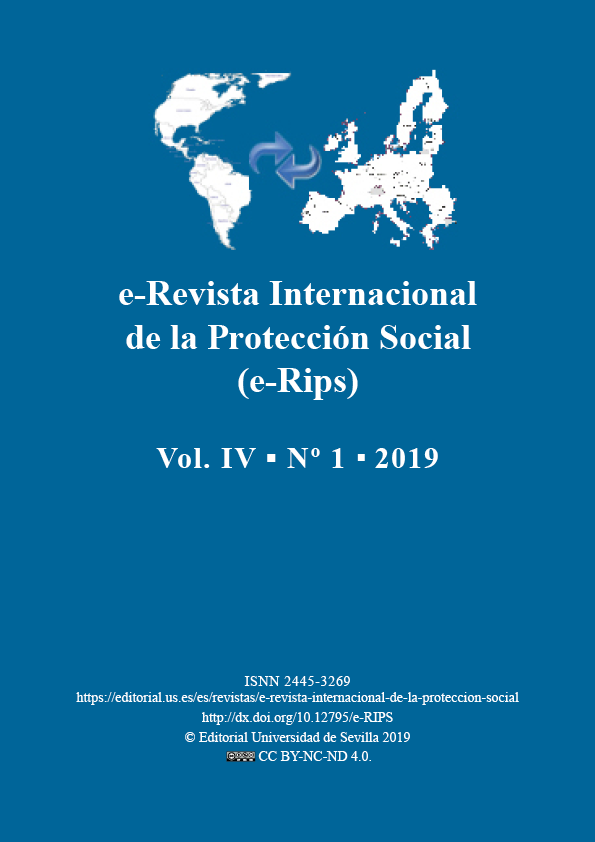FISCAL COMPACT ED ATTUAZIONE DEL PILASTRO EUROPEO DEI DIRITTI SOCIALI IN ITALIA
DOI:
https://doi.org/10.12795/e-RIPS.2019.i01.07Resumen
Il 26 Aprile 2017 la Commissione Europea ha adottato la proposta di “Pilastro Europeo dei diritti sociali”, che dovrebbe vincolare tutti i Paesi della zona euro, ed essere aperto anche a tutti gli altri Paesi dell’Unione Europea che desiderino aderirvi.
Il Pilastro Europeo stabilisce principi e diritti fondamentali per sostenere il buon funzionamento e l’equità dei mercati del lavoro e dei sistemi di protezione sociale.
Contemporaneamente il Trattato sulla stabilità, sul coordinamento e sulla governance dell’Unione Europea, il cosiddetto “fiscal compact” firmato il 2 Aprile 2012, impone dei vincoli alla politica economica degli Stati aderenti, ancora più stringenti di quelli già fissati con il Trattato di Maastricht e ribaditi nel Trattato di Funzionamento dell’Unione Europea.
Nel presente lavoro si vuole capire, prendendo in esame in particolare lo Stato Italiano, se sia possibile attuare il Pilastro Europeo dei diritti sociali rispettando contemporaneamente i vincoli imposti dal fiscal compact.
Descargas
Descargas
Publicado
Cómo citar
Número
Sección
Licencia
e-Revista Internacional de la Protección Social es una revista de acceso abierto, lo que significa que todo su contenido está disponible gratuitamente para el usuario o su institución. Los usuarios pueden leer, descargar, copiar, distribuir, imprimir, buscar o enlazar con el texto completo de los artículos, o utilizarlos para cualquier otro fin lícito, sin solicitar permiso previo al editor o al autor. Esta definición de acceso abierto se ajusta a la Iniciativa de Acceso Abierto de Budapest (BOAI).
 4.0
4.0
A menos que se indique lo contrario, todo el contenido de la edición electrónica se distribuye bajo una " licencia internacional Creative Commons Atribución-Nocomercial-Compartirigual 4.0 Internacional". Puede consultar la versión informativa y el texto legal de la licencia aquí. Esto debe indicarse expresamente de esta manera cuando sea necesario.
En caso de aceptación del manuscrito, los autores ceden los derechos de la obra para su publicación a eRIPS. Revista Internacional de la Protección Social bajo el contrato de licencia Reconocimiento-NoComercial-CompartirIgual 4.0 Internacional (CC BY-NC-SA 4.0). Los autores conservan los derechos de autor y terceros están autorizados a compartir y adaptar la obra, siempre que cumplan con los términos y condiciones establecidos en la licencia.
- Usted debe dar crédito de manera adecuada , brindar un enlace a la licencia, e indicar si se han realizado cambios . Puede hacerlo en cualquier forma razonable, pero no de forma tal que sugiera que usted o su uso tienen el apoyo de la licenciante.
- Usted no puede hacer uso del material con propósitos comerciales .
- Si remezcla, transforma o crea a partir del material, debe publicar sus contribuciones bajo la misma licencia que el original.
Se puede encontrar más información en https://creativecommons.org/licenses/by-nc-sa/4.0/deed.es
Se permite y recomienda a los autores/as difundir su obra a través de Internet (p. ej.: en archivos telemáticos institucionales o en su página web) antes y durante el proceso de envío, lo cual puede producir intercambios interesantes y aumentar las citas de la obra publicada.











